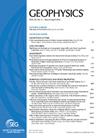Microseismic event locations and source mechanisms using dominant guided waves recorded in an underground potash mine
IF 3
2区 地球科学
Q1 GEOCHEMISTRY & GEOPHYSICS
引用次数: 0
Abstract
Microseismic event locations and moment tensors in underground mines can provide insights into the subsurface deformation and the current state of stress. However, reliable estimation of these source parameters is rather challenging due to the high-frequency waveforms and low signal-to-noise ratio for negative magnitude events. We study microseismicity in an underground potash mine in Saskatchewan, Canada, recorded between March 1 and June 30, 2021, by a network of broadband seismometers. The active mining is carried out in low-velocity evaporites at depths of approximately 1 km below the ground level. The theoretical dispersion curves show that guided waves in the form of leaky P and P-SV/SH normal modes can exist in a 1D velocity model representing the mine geology. These guided waves are detected as high-energy dispersive arrivals on the seismograms recorded at the underground receivers. We locate the events using the arrival times of the guided waves and their mean group velocities. Most (∼80%) of the detected events cluster around the mine layout between depths of 0.95 to 1.05 km. Next, we compute moment tensors for 92 events using waveforms of guided phases. The moment tensors show non-double couple components with only 28 events having double-couple percentages greater than 50%. These events occur near the mined-out cavities with source mechanisms corresponding to layer delamination in the roof and floor or pillar yield related to the closure of cavities. No abnormal microseismicity is detected away from the mine levels in the more competent carbonate rocks above or below the evaporite formations. Thus, guided waves enable the detection of microseismic events up to large distances and can provide high-resolution event locations and moment tensor inversion. These can be interpreted in the context of local geology and mining activities to identify the dominant factors affecting microseismicity.利用主导导波记录的地下钾肥矿微地震事件位置和震源机制
井下微震事件位置和矩张量可以提供井下变形和应力现状的信息。然而,由于负震级事件的高频波形和低信噪比,这些源参数的可靠估计相当具有挑战性。我们研究了加拿大萨斯喀彻温省一个地下钾肥矿的微地震活动,这些微地震活动是由宽带地震仪网络在2021年3月1日至6月30日记录的。活动采矿是在地下约1公里深处的低速蒸发岩中进行的。理论频散曲线表明,在代表矿山地质的一维速度模型中,导波以泄漏P型和P- sv /SH型正态存在。这些导波是在地下接收器记录的地震仪上探测到的高能量色散到达。我们利用导波的到达时间和它们的平均群速来定位事件。大多数(~ 80%)探测到的事件聚集在0.95至1.05 km深度之间的矿山布局周围。接下来,我们使用导相波形计算92个事件的矩张量。矩张量显示非双偶分量,只有28个事件双偶百分比大于50%。这些事件发生在采空区附近,其源机制对应于顶板分层或与采空区闭合相关的矿柱屈服。在远离矿井的地方,在蒸发岩地层上方或下方的碳酸盐岩中,没有检测到异常的微震活动。因此,导波可以探测到远距离的微地震事件,并提供高分辨率的事件位置和矩张量反演。这些可以在当地地质和采矿活动的背景下解释,以确定影响微震活动的主要因素。
本文章由计算机程序翻译,如有差异,请以英文原文为准。
求助全文
约1分钟内获得全文
求助全文
来源期刊

Geophysics
地学-地球化学与地球物理
CiteScore
6.90
自引率
18.20%
发文量
354
审稿时长
3 months
期刊介绍:
Geophysics, published by the Society of Exploration Geophysicists since 1936, is an archival journal encompassing all aspects of research, exploration, and education in applied geophysics.
Geophysics articles, generally more than 275 per year in six issues, cover the entire spectrum of geophysical methods, including seismology, potential fields, electromagnetics, and borehole measurements. Geophysics, a bimonthly, provides theoretical and mathematical tools needed to reproduce depicted work, encouraging further development and research.
Geophysics papers, drawn from industry and academia, undergo a rigorous peer-review process to validate the described methods and conclusions and ensure the highest editorial and production quality. Geophysics editors strongly encourage the use of real data, including actual case histories, to highlight current technology and tutorials to stimulate ideas. Some issues feature a section of solicited papers on a particular subject of current interest. Recent special sections focused on seismic anisotropy, subsalt exploration and development, and microseismic monitoring.
The PDF format of each Geophysics paper is the official version of record.
 求助内容:
求助内容: 应助结果提醒方式:
应助结果提醒方式:


